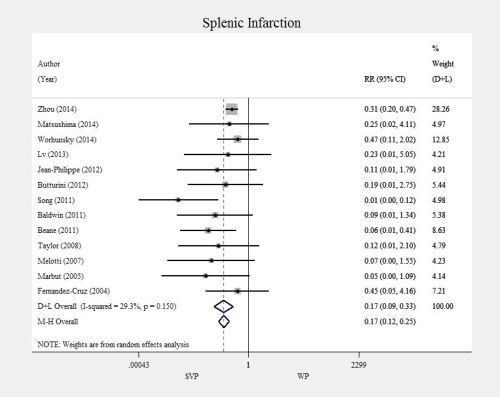|
Back to 2015 Annual Meeting Program
Spleen Preserving Distal Pancreatectomy (Spdp): Does Splenic Vessel Preservation (Svp) Have Better Postoperative Outcomes - a Systematic Review and Meta-Analysis
Fady Elabbasy*, Rahul Gadde, Mena Hanna, Danny Sleeman, Alan S. Livingstone, Danny Yakoub
Surgical Oncology, University of Miami Sylvester Comprehensive Cancer Center, Miami, FL
BACKGROUND:
Spleen-preserving distal pancreatectomy (SPDP) can be performed with either splenic vessel preservation (SVP) or resection (Warshaw procedure (WP)). The aim of this systematic review was to evaluate the short and long-term postoperative clinical outcomes of patients undergoing both methods.
METHODS:
Online search of PubMed, MEDLINE, EMBASE, SCOPUS, COCHRANE, and GOOGLE SCHOLAR was performed. Key bibliographies were reviewed. Studies comparing patients undergoing SPDP with either SVP or WP, and assessing postoperative complications were included. Calculated pooled relative risk with the corresponding 95% confidence interval (CI) by random effects methods were used in the meta-analysis. Studies' methodological quality was assessed by the STROBE criteria.
RESULTS:
The search yielded 205 studies, of which only 14 observational studies met our selection criteria. The studies included a total of 943 patients; 291 (31%) underwent WP and 652 (69%) underwent SVP. Overall, there was a lower incidence of splenic infarction (RR 0.17; 95% CI 0.09 - 0.33; p <0.001), gastric varices (RR 0.16; 95% CI 0.05 - 0.51; p = .002), and intra/postoperative splenectomy (RR 0.21; 95% CI 0.09 - 0. 49; p <0.001) in the SVP group. There was no difference in incidence of pancreatic fistula (WP vs SVP, 23.6% vs 22.9%; p = 0.37), length of stay, operative time or blood loss. There was moderate cross-study heterogeneity.
CONCLUSIONS:
SVP-SPDP seems to have a reduced incidence of postoperative splenic infarction and gastric varices. The results should be viewed with caution, as all studies were retrospective. Larger randomized controlled trials are justified to validate these findings.

Back to 2015 Annual Meeting Program
|


